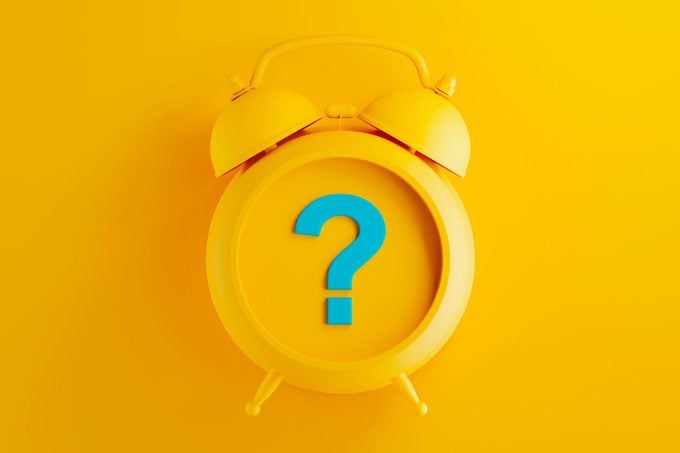What Would Happen If We Got Rid of Daylight Saving Time?
Updated: Mar. 07, 2024

Is daylight saving time ending in 2024, and what happens if there is no more DST? Here's the scoop!
The start of daylight saving time is almost here! We advance the clocks on Sunday, March 10 (with DST ending for the year on Sunday, Nov. 3). Once DST starts at 2 a.m., we’ll lose an extra hour (bummer!), whereas falling back in November will give us an extra hour (we can’t wait!). This practice has been in effect for years, but have you ever wondered what would happen if there was no more daylight savings?
Though more than 70 countries observe this twice-annual tradition, including the United States, there is a movement underway to do away with DST—and for good reasons! According to Anna Persaud, PhD, a biochemist and the CEO of This Works, “even a one-hour daylight saving misalignment can negatively impact physiological processes, resulting in disruptive symptoms such as poor sleep and reduced cognitive functioning.”
So if you’re curious about what life would be like with no more daylight savings, read on to learn more!
Get Reader’s Digest’s Read Up newsletter for more fun facts, travel, humor, cleaning and tech all week long.
About the experts
|
Is daylight saving time ending?
As of this writing, daylight saving time is not ending across the United States. However, Sen. Marco Rubio did reintroduce the Sunshine Protection Act, a bill that would make DST permanent, to Congress in early March 2023. We’re still waiting to see if it will move forward.
What states are getting rid of daylight saving time?
So far, only two states, Hawaii and Arizona, have opted out of DST, and that was back in the 1960s—but more changes have happened across the United States since. According to the National Conference of State Legislatures, 19 states—including Florida, Minnesota and Ohio—have passed legislation calling for permanent daylight saving time if allowed. (Federal law allows states to change to permanent standard time, but not DST.) Both Oklahoma and Texas have pending legislation to make standard time permanent, but in each state, it has passed in only one of the legislative chambers.
These movements to end DST aren’t just happening in the United States. In 2018, the European Parliament voted to eliminate the biannual clock change; however, negotiations in the EU Council haven’t started yet.
What would happen if there was no more daylight savings?

We all know that the day we spring forward into daylight saving time is one of the most unpleasant days of the spring season. Losing an hour of sleep overnight—what could be worse? The groggy morning afterward actually sees a spike in accidents and medical emergencies, which is why many are in favor of ending daylight saving time altogether. Here’s what would happen if there was no more daylight savings and the common reasons why people want to get rid of the practice for good.
Better sleep
Whether you’re changing the clock forward or backward, it can have a negative impact on a person’s circadian rhythm. It can take five to seven days for your body to adjust to the new time schedule, reports the American Academy of Sleep Medicine, and the disruption in sleep can lead to even bigger health issues.
Reduced risk of heart issues
Research has found that the spring DST changes are associated with a 24% increase in acute myocardial infarction (AMI) events on the Monday following the change and that switching our clocks may increase the risk of heart attacks. While the research hasn’t indicated why this may be, those who experienced an increased risk were mostly people who were already predisposed to experiencing heart issues. However, research also shows that heart attacks decrease by 21% the week DST ends in the fall. Still, if more states got rid of daylight saving time, it’s possible that more lives could be saved overall.
Reduced risk of stroke
Similarly, research has found an increase in hospitalizations for stroke in the two days following the DST change, with the overall rate of ischemic stroke being 8% higher in those days than at any other time of the year. The American Academy of Neurology speculates this may be because of the disruption in circadian rhythms caused by DST, as previous studies have shown that can play a part in increasing a person’s risk of stroke.
Reduced costs
“A major con that comes with DST is that it’s very costly for companies, since business hours and operations need to adjust every spring,” says Liz Brown, the founder of Sleeping Lucid. In fact, experts estimate the biannual time change costs the United States around $430 million every year. The increase in heart attacks and workplace injuries, plus lowered productivity, are all accounted for in the total cost.
Fewer auto accidents
The changing of the clocks has also been associated with an increase in fatal auto accidents, particularly on the Monday following the spring shift. Experts theorize that these auto accidents occur because drivers are tired from losing the hour of sleep after the spring change. If there was no more daylight savings, the number of fatal accidents could be reduced.
Lower crime rates
One other consideration to keep in mind with DST is how it impacts crime levels. Research has found that by extending evening daylight hours, as we do in the spring, crime rates actually go down, with robberies being reduced by 7% from the day before, and overall crime going down by 27% in the additional evening hour of sunlight gained on that day. On the flip side, another study found that with the hour of daylight lost in the fall, assault rates went up by 3% on the Monday following the time change.
How do I prepare myself for daylight saving time?

Persaud shares three ways you can prepare your mind and body for this time shift:
- Change the timing of your meals: “Eating your three meals 15 to 30 minutes progressively earlier can help anchor the circadian rhythm and get the body used to its new routine,” says Persaud. She recommends avoiding large meals and spicy foods, as they can cause heartburn and irritation to your digestive system. And, she adds, “leaving a four- to five-hour gap between your last meal of the day and bedtime increases sleep duration and decreases awakening after sleep.”
- Shift your sleep schedule: “Gradually shifting your sleep schedule helps counteract the negative effects of daylight saving by allowing your body to adapt to the upcoming time change in a more natural and gentle manner,” Persaud says. Work on changing your sleep schedule for several days leading up to DST; that way, the time change won’t disrupt your internal body clock quite as much. “This approach promotes a smoother transition and reduces the risk of experiencing sleep disturbances and associated negative effects on mood, energy levels and overall health.”
- Create a bedtime routine: If you don’t have a sleep schedule, DST is the perfect time to make one. “Regardless of the time change, maintaining a regular bedtime routine helps regulate your circadian rhythm by creating predictable cues that promote relaxation and prepare your body for rest,” Persaud says. “This consistency reinforces your body’s internal sleep-wake cycle, making it easier to adjust to shifts in daylight hours associated with daylight savings.” And if you struggle with sleep, try calming activities, such as reading or taking a warm bath, to help yourself adjust to DST’s time shift.
Why trust us
At Reader’s Digest, we’re committed to producing high-quality content by writers with expertise and experience in their field in consultation with relevant, qualified experts. We rely on reputable primary sources, including government and professional organizations and academic institutions as well as our writers’ personal experience where appropriate. We verify all facts and data, back them with credible sourcing, and revisit them over time to ensure they remain accurate and up to date. Read more about our team, our contributors and our editorial policies.
Sources:
- Anna Persaud, PhD, biochemist and CEO of This Works; email interview, Feb. 23, 2024
- Liz Brown, founder of Sleeping Lucid
- Sleep Medicine: “Changes in ischemic stroke occurrence following daylight saving time transitions”
- American Academy of Neurology: “Does Daylight Saving Time Increase Risk of Stroke?”
- Sleep Medicine: “Fatal Accidents Following Changes in Daylight Savings Time: The American Experience”
- Journal of Experimental Criminology: “Aggression and sleep: a daylight saving time natural experiment on the effect of mild sleep loss and gain on assaults”
- National Conference of State Legislatures: “Daylight Saving Time | State Legislation”
- American Academy of Sleep Medicine: “New position statement supports permanent standard time”



